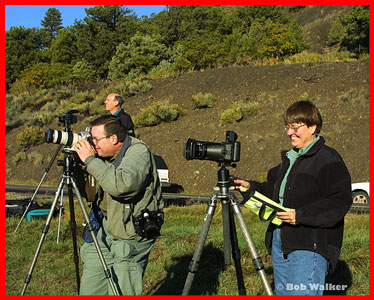USING GRADUATED NEUTRAL DENSITY FILTERS
Mt. Sneffels, San Juan Mountains, Colorado. Photo © Jim Doty, Jr.
A common problem for nature photographers is the contrast range between bright skys and a darker foreground, or a bright scene and a much darker reflection of that scene in a lake or pond. Expose for the bright part of the scene and the dark part disappears. Expose for the dark part of the scene and the bright part is washed out. For years, the secret weapon for such situations has been the graduated neutral density filter (also called a graduated gray filter or split neutral density filter).
A "grad" filter is half clear and half neutral density (one or two stops darker than the clear section) with a gradation zone in the middle. Grad filters are usually square and can be rotated and moved up and down in a filter holder that mounts on the front of your lens. The darker part of the filter is put over the bright part of the scene with the clear part of the filter over the dark part of the scene. With the light part of the scene toned down by one, two, or three stops (the most common strengths), the contrast has been tamed for a more pleasing picture.
When I use a grad filter, I meter first and align later. I set my camera in manual mode and choose the aperture I want.
With the grad filter in place, I meter the light part of the scene through the dark part of the filter and note the shutter speed. Then I meter the dark part of the scene through the clear part of the filter and note the shutter speed. If the shutter speeds are the same, all is golden. If they aren't, I shoot at both shutter speeds plus everything in between in half or third stop increments.
If the two meter readings are really far apart, I switch to a stonger grad (time permitting).
I move the filter up or down for the meter readings so the meter isn't confused by the gradation zone in the middle of the filter. I slide the filter down so the lens/meter sees through only the darker part of the filter when metering the brighter part of the scene. Then I slide the filter up so the lens/meter sees only through the clear part of the filter when metering the darker foreground.
Once the shutter speed (or speeds) have been determined, I stop the lens down to its taking aperture and position the filter before taking the photos. The location of the gradation zone will shift as apertures are changed so its important to stop down to the taking aperture when positioning the filter.
This all goes much faster than it sounds. (1) Slide filter down, aim at the sky and meter. (2) Slide filter up, aim at the foreground and meter. (3) Recompose, position gradation line and shoot.
If I don't have time to meter both areas, I only meter the light part of scene through the dark part of the filter, recompose, shoot and bracket. I think the greater photographic "sin" is a washed out sky than an underexposed foreground.
You can get filters with a soft or hard gradation (the soft gradation is more gradual) and the neutral density part of the filter can range from one stop to 5 stops.
My most used grad is a two f-stop filter with a soft gradation zone. My second choice is a 3 f-stop grad with a hard gradation zone.
A two stop soft grad was used on the photo at the top. The dark part of the filter was over the peak and sky and the clear part of the filter was over the foregorund and snow covered hills.
In the digital era, a lot of photographers take several exposures based on the light and dark poart of the scenes and composite them together in the computer. This works but it is a lot of work. It is still better, if at all possible, to get it right in the camera with a grad filter.
Singh-Ray makes my favorite brand of grad filters and they have several examples of their use.

Bob Walker took this photo of me (left) and Kathleen Norris Cook (right) as we photographed Mt. Sneffels. It is hard to see in this photo, but we are both using graduated neutral density filters. She does some stunning photography.